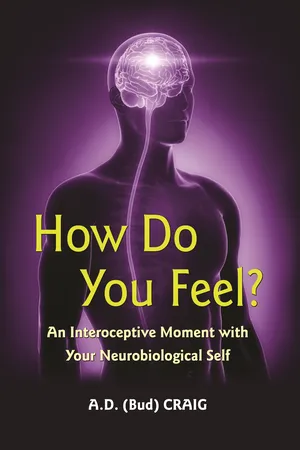
- 368 pages
- English
- ePUB (mobile friendly)
- Available on iOS & Android
About this book
A book that fundamentally changes how neuroscientists and psychologists categorize sensations and understand the origins and significance of human feelings
How Do You Feel? brings together startling evidence from neuroscience, psychology, and psychiatry to present revolutionary new insights into how our brains enable us to experience the range of sensations and mental states known as feelings. Drawing on his own cutting-edge research, neurobiologist Bud Craig has identified an area deep inside the mammalian brain—the insular cortex—as the place where interoception, or the processing of bodily stimuli, generates feelings. He shows how this crucial pathway for interoceptive awareness gives rise in humans to the feeling of being alive, vivid perceptual feelings, and a subjective image of the sentient self across time. Craig explains how feelings represent activity patterns in our brains that signify emotions, intentions, and thoughts, and how integration of these patterns is driven by the unique energy needs of the hominid brain. He describes the essential role of feelings and the insular cortex in such diverse realms as music, fluid intelligence, and bivalent emotions, and relates these ideas to the philosophy of William James and even to feelings in dogs.
How Do You Feel? is also a compelling insider's account of scientific discovery, one that takes readers behind the scenes as the astonishing answer to this neurological puzzle is pursued and pieced together from seemingly unrelated fields of scientific inquiry. This book will fundamentally alter the way that neuroscientists and psychologists categorize sensations and understand the origins and significance of human feelings.
Frequently asked questions
- Essential is ideal for learners and professionals who enjoy exploring a wide range of subjects. Access the Essential Library with 800,000+ trusted titles and best-sellers across business, personal growth, and the humanities. Includes unlimited reading time and Standard Read Aloud voice.
- Complete: Perfect for advanced learners and researchers needing full, unrestricted access. Unlock 1.4M+ books across hundreds of subjects, including academic and specialized titles. The Complete Plan also includes advanced features like Premium Read Aloud and Research Assistant.
Please note we cannot support devices running on iOS 13 and Android 7 or earlier. Learn more about using the app.
Information
Table of contents
- Cover Page
- Title Page
- Copyright Page
- Contents
- List of Figures and Plates
- List of Boxes
- Preface
- 1 An Introduction to Interoception
- 2 Feelings From the Body Viewed as Emotions: Ideas from the lamina I projection map that add to the textbooks
- 3 The Origin of the Interoceptive Pathway: Homeostatic sensory fibers and the interoceptive dorsal horn
- 4 Interoception and Homeostasis: Lamina I terminations at cardiorespiratory sites in the brainstem
- 5 The Interoceptive Pathway to the Insular Cortex: Lamina I spinothalamic input to the thalamus and cortex in primates
- 6 Bodily Feelings Emerge in the Insular Cortex: Interoceptive integration generates the feeling of being alive
- 7 Feelings About Thoughts, Time, and Me: Awareness emerges in the anterior insular cortex
- 8 Feelings and Emotions on Both Sides of the Brain: The asymmetric forebrain
- 9 A Few More Thoughts about Feelings: Graded sentience and tail-wagging in dogs
- Acknowledgments
- Abbreviations
- Glossary
- Reference List
- Illustration Credits
- Index